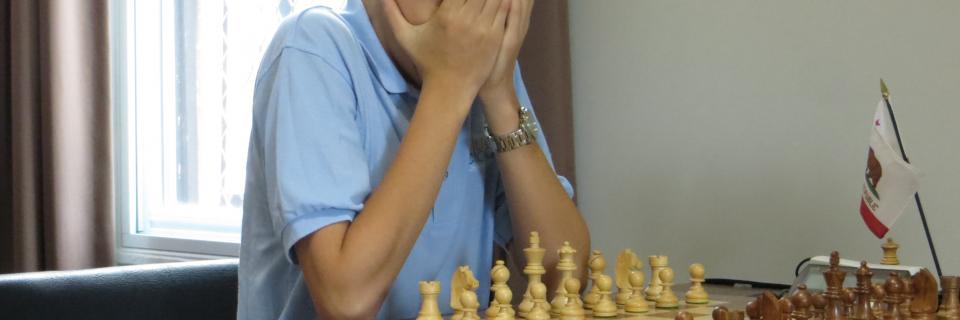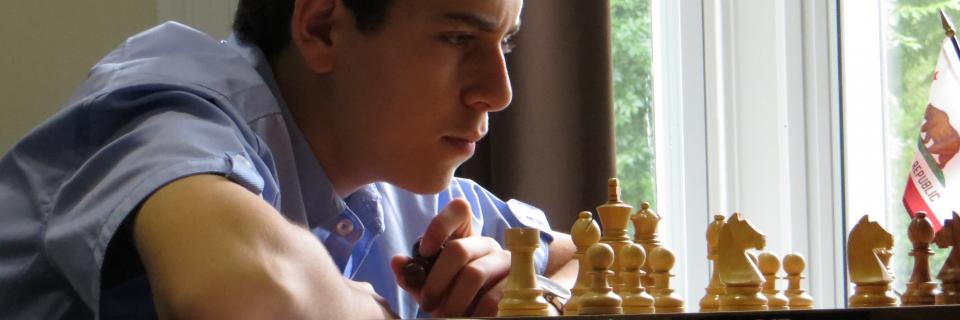2012 U.S. Championships News

Grandmaster Levon Aronian of Armenia is currently ranked No. 2 in the world and holds a plus score agaisnt both of the U.S. competitors, Hikaru Nakamura and Gata Kamsky.
By Brian Jerauld
Grandmaster Levon Aronian is the pride of chess-strong Armenia, having been declared Sportsman of the Year twice, Honored Master of Sport in 2009 and, most recently, selected as the 2012 Person of the Year by a leading Armenian magazine. The 30-year-old is just the sixth player in history to cross the elite 2800 threshold, currently ranking No. 2 in the world at 2802. Aronian has remained in the world’s top three since November 2010 and has only twice slipped out of the top ten since July 2005.
Taught to move the pieces at 9 years old, Aronian was quick to appear on the world stage, winning the 1994 World Youth Chess Championship U12. In 2002, at 20, he won the Armenian Championship and later the World Junior Championship in India. But his mainstay in the world’s elite was marked in 2005, when he won the World Cup in Russia and cracked the world’s top 10 for the first time. Since then, Aronian has collected a staggering amount of elite titles.
He played the first board on three gold-medalist Armenian Chess Olympiad teams (2006, 2008 and 2012), also grabbing the individual gold in 2012. He has won the prestigious Tal Memorial and Corus/Tata Steel Chess Tournament three times each, and the FIDE Grand Prix twice. In 2009, he won the World Rapid Championship – a title that was taken from him the following year by Gata Kamsky – and in 2010 Aronian won the World Blitz Championship – a title that he took from defending champion Magnus Carlsen.
Aronian is also a talented chess variant player, becoming the Chess960 World Champion in 2006. He successfully defended the title to Viswanathan Anand in 2007, though lost it in 2009 to Hikaru Nakamura.
His play in 2013 leading up to the Sinquefield Cup has been representative of his elite status. A second place finish in the Tata Steel (behind Carlsen), a fourth place finish in the 2013 Candidates Tournament – his second appearance in the event – and a win at the Alekhine Memorial Tournament. Perhaps showing a bit of his human side, however, Aronian was surprisingly upset in the third round of the 2013 Chess World Cup in August, despite being the top seed.
In his career against Kamsky, Aronian is 5-1 with 2 draws; against Nakamura, Aronian is 5-3 with 7 draws. By far, his most familiar Sinquefield Cup opponent is Carlsen, with whom he has met for 35 classical games – Carlsen holds the series 7-4, with 24 draws.
Grandmaster Gata Kamsky, the reigning U.S. Champion, will take on three of the world's best at the Sinquefield Cup.
By Brian Jerauld
Gata Kamsky is a Soviet-born, American grandmaster, currently ranked No. 2 in the United States and No. 19 in the world, with a FIDE rating of 2733. He was born in Siberia, Russia, in 1974 and learned chess at 7 years old. By 9, he had won the Under-15 USSR Championship, and then became a back-to-back Junior Champion of the Soviet Union at 13.
Kamsky emigrated to the U.S. in 1989 and earned his FIDE Grandmaster title the following year, also becoming the youngest player ever rated in the world's top-ten.
Kamsky’s impact on American chess has been profound, having been the highest-rated American since his arrival in 1989 – second only now to Hikaru Nakamura. Kamsky won his first of four U.S. Championships in 1991, and the following year helped America grab its first-ever gold in the World Team Chess Olympiad.
In 1994, at age 20, Kamsky became the youngest-ever to challenge for the FIDE world title and the first American since Bobby Fischer. The 20-game match against reigning champion Anatoly Karpov was finally held in 1996, in Elista, Kalmykia, in Russia. Kamsky lost the match 7.5-10.5, but substantial political controversy surrounding the event ultimately led to an eight-year hiatus from professional chess for the American GM, partially in protest.
Kamsky returned in 2004 – “past his prime” at 30 years old – for an extraordinary second chapter in his career. By 2007, he had regained his elite form, qualifying for the Candidates Tournament that year and later winning the Chess World Cup as the 11th seed, knocking off Magnus Carlsen in the semifinals. In 2010, Kamsky won his second U.S. Championship – 19 years removed from his first title – and returned to successfully defend the crown in 2011.
Kamsky’s play in 2013 leading up to the Sinquefield Cup has been some of the finest in his career. He earned his fourth U.S. Championship title in May, then rolled hot into the fourth stage of the FIDE Grand Prix, taking second place in Thessaloniki, Greece. His FIDE rating crested at 2763 in July, the highest ever in his career. Just before arriving in Saint Louis for the Sinquefield Cup, Kamsky went deep in the Chess World Cup 2013, but was ultimately knocked out by GM Evgeny Tomashevsky in the quarterfinals.
In nine classical games versus Carlsen, Kamsky holds a 2-1 record with six draws. In eight matches against Levon Aronian, Kamsky has won only once against five losses, with two draws. Nakamura and Kamsky are tied 1-1 with 6 draws over eight career games.
Will feature 3 GM commentary teams and free autograph session with players

Maurice Ashley interviews Gata Kamsky after Kamsky won the 2013 U.S. Championship. Ashley will join Jennifer Shahade and Yasser Seirawan once again for live commentary of the 2013 Sinquefield Cup.
SAINT LOUIS (August 12, 2013) -- The 2013 Sinquefield Cup will offer live spectators a bevy of options come September.
The tournament, which features GMs Magnus Carlsen and Levon Aronian (top two in the World) and GMs Hikaru Nakamura and Gata Kamsky (top two in the U.S.) takes place September 9-15 at the Chess Club and Scholastic Center of Saint Louis (CCSCSL).
There also will be a special meet-and-greet autograph session on Sunday, September 8, from Noon to 1:30 p.m., where spectators will have the opportunity to get autographs from and take pictures with the players. This event is free, and fans will be admitted on a first-come, first-served basis.
Round one of the tournament begins at 1 p.m. CT on September 9.
Three different grandmaster commentary teams will be on site to offer live play-by-play and analysis of each round of this historic tournament.
Following their groundbreaking live commentary of the 2013 U.S. Championships, GMs Yasser Seirawan and Maurice Ashley will once again join WGM Jennifer Shahade on a closed set that will broadcast to thousands of viewers online via www.uschesschamps.com.
Two other teams (comprised of GMs Varuzhan Akobian, Ben Finegold, Ronen Har-Zvi and one additional commentator TBD) also will be conducting commentary for live audiences at Lester’s Restaurant (connected to the CCSCSL) and the World Chess Hall of Fame (across the street from the CCSCSL).
Tony Rich, the executive director of the CCSCSL, said additional commentary teams will create a dynamic and engaging spectator experience.
“We wanted to offer a variety of options to ensure a positive experience for club members and visitors alike.” he said.
Event spectators will have the option to observe the players in the tournament playing hall, listen to the live streaming online commentary in a special viewing area at the Chess Club, or sit in on either of the live audience broadcasts. Tickets for individual rounds cost just $15 and also include food and beverage. Click here to purchase tickets or to view ticket package information.
In addition, the World Chess Hall of Fame will present a preview of their upcoming exhibit Jacqueline Piatigorsky: Patron, Player, Pioneer on the first floor gallery alongside the live GM commentary. The exhibition will be on view from September 4-15 and will include artifacts related to the 1963 and 1966 Piatigorsky Cup tournaments, two of the strongest chess competitions to be held in the U.S. These events attracted top grandmasters from around the world, including Boris Spassky, Bobby Fischer, Tigran Petrosian and Paul Keres.
The Sinquefield Cup marks Carlsen’s first-ever high-profile tournament in the United States. The event, a four-player, double round robin, features a $170,000 prize fund and an average FIDE rating just under 2800, making it the strongest tournament in the history of the U.S.
The event is named after the founders of the CCSCSL, Jeanne and Rex Sinquefield. The Sinquefields were each honored by the U.S. Chess Federation with a Gold Koltanowski award in 2012, with Rex also earning the distinction in 2009, 2010 and 2011. The award is given to the person or persons who have done the most to promote chess in the U.S. each year.
For more information including area hotels with special chess rates, visit http://www.uschesschamps.com/sinquefield-cup
 International Master Daniel Naroditsky went undefeated through nine rounds to win the 2013 U.S. Junior Closed Championship.
International Master Daniel Naroditsky went undefeated through nine rounds to win the 2013 U.S. Junior Closed Championship.
By Brian Jerauld
SAINT LOUIS (June 24, 2013) -- On Sunday, IM Daniel Naroditsky went clutch to win his final game of the 2013 U.S. Junior Closed Championship, breaking a tie with FM Luke Harmon-Vellotti and earning the crown in clear first – proving, once again, that slow and steady wins the race.
Naroditsky finished with 6.5/9 after going directly for the win with the black pieces in round 9 against Robert Perez, while Harmon-Vellotti was stalled with a draw to FM Jeffrey Xiong. FM Sam Sevian’s last-round win over WFM Sarah Chiang completed a tenacious come-from-behind effort – four wins and two draws to close the tournament – but he was ultimately only able to catch Harmon-Vellotti to tie for second at 6.0.
“It was quite grueling – especially being the favorite coming in, where the pressure is on and everyone expects you to win every game,” Naroditsky said. “I just tried to stay calm and tranquil in every moment.”
All said and done, it comes as no shocker that Naroditsky became this year’s champion. The California 17-year-old was a three-time veteran of the tournament and the highest-rated player in this year’s field, at 2494. What comes as a surprise is how he did it.
In an often dramatic and decisive tournament that featured sharp play and homerun swings nearly every afternoon, each of Naroditsky’s games instead plodded along at a careful and steady positional pace. Offering an array of polished openings throughout, he kept his opponents in constant speculation as to which game they would play: One that spent 50 moves battling slowly over the smallest of advantages – or one that could be just as quickly traded down to a draw in 20. His methods earned him four wins and five draws, the only unbeaten player through the tournament.
By the end, his approach looked systematic – drawing against the top five finishers and collecting full points from the bottom four. He never once fell lower than second place, yet also never led the field by more than half a point. The closest game he wore as a loss came after a winning position against FM Yian Liou, who finished in sixth place, narrowly slipped away into a draw. It allowed Harmon-Vellotti to catch pace for the last round; Naroditsky had been in clear first and the draw left him rattled, vowing to return on Sunday to win at all costs against Perez.
“I feel great, happy with the fact that was able to work hard under pressure and get back on my feet after some tough draws and tough moves – something I have not done in past Juniors,” Naroditsky said. “I was really happy I was able to get my stuff together and find some winning spirit for a nice win at the end.”
Naroditsky selected the King’s Indian Defense in seeking a win over Perez, who held the tension in the center when black pushed 9. … e5. Naroditsky opted to break it open with 12. … exd4, and soon both of his knights enjoyed central outposts on c5 and e5. The thematic 17. … f5 swung the game in Naroditsky’s favor, ultimately winning the white e-pawn and granting black control of the open a-file – all but ending white’s standard attack plans on the queenside.
With Perez in massive time trouble, Naroditsky leaned on his pawn advantage in a slow positional advance, lodging his knight on a devastating central outpost with 29. … e4. It brought safety to the last square needed for a net on the white queen, and after Perez – playing on increment – blundered with 32. a1?, Naroditsky won the lady with 32. Bc5. It was the third time this tournament Perez hung his queen.
Sharing the lead entering the final round, Harmon-Vellotti also played directly for a win but came up just a few tempos short as the black pieces in his eventual draw against Xiong. The tactically adept Idaho 14-year-old thrived all week in complicated positions, and once again steered the game into a closed mess with his trademark French Defense.
Though black enjoyed some advancement on the queenside, an early rook lift by white eventually found 15. Rg3, of which black’s response in 15. … Bf8 blocked any castling plans for his king. Harmon-Vellotti’s monarch never did make it out of the middle – a weakness Xiong had fully exploited by the game’s adjournment – and his h8 rook never once moved out of the corner.
The queenside was breaking open by the 20th move, and while black lost its a-pawn to 25. Rxa5, it was able to create a particularly bothersome passed pawn with 27. … dxc4. Desperate for a win, it became the object of Harmon-Vellotti’s attention, but not without first dealing with Xiong’s own passer on the seventh rank: 33. d7 offered an awkward check by a violently poisoned pawn.
In the end, the pressure on Harmon-Vellotti’s king, still on the e-file and pinned down by the white queen, proved too much. Ironically, Harmon-Vellotti’s army ran out of initiative just as Naroditsky stood up from his board, with congratulations. The game was drawn by repetition after 44 moves, just a few minutes after the championship had been claimed.
“I was about to offer a draw at that point anyway; I only had one way not to lose,” Harmon-Vellotti said. “I played my best and, at the end, it was a draw. I’m not disappointed with this tournament, I still played well for the most part.”
Sevian delivered a quick and convincing must-win as black over Chiang in his final round – for the moment putting him in clear first – and then sat for nearly an hour to nervously await the Naroditsky and Harmon-Vellotti results.
Chiang now has plenty of resources to learn the Nimzo-Indian lines as the players ganged up on her with the defense all week. Fighting came quickly, as Chiang’s 7. d5 pushed the envelope on black’s center, but opened up a diagonal that brought Sevian’s 8. … Bxf1 and forced Chiang’s king to move before castling. Soon her e-pawn was attacked without enough defensive resources; Sevian won it with 13. Nxe4, kicking off some nice tactical work that also traded the queens and minor pieces from the board.
A few half-steps from white allowed black to finish its development, and soon Chiang’s d-pawn was sucked too far into the black camp. She missed moving her rook out of the pin on the e-file at 24. Re4, instead allowing Sevian to force a trade of the knights and spell doom for the advanced pawn. Sevian went on to create a tomb of pawns around the white rook with 27. … c4, and then beautifully sealed it off with 31. d5.

By Brian Jerauld
SAINT LOUIS (June 23, 2013) -- California IM Daniel Naroditsky and Idaho FM Luke Harmon-Vellotti met in round 2 of the 2013 U.S. Junior Closed in a game that fizzled into an uninspiring draw. And after quickly trading his way down to an opposite-colored bishop snoozer, Naroditsky admitted that the draw was more for practical reasons.
“At some point, it’s important to make a prudent decision. You don’t always have to go all-in,” he said at the time. “Sometimes the decision is not justified, sometimes it is. We’ll just see how it goes for the rest of the tournament.”
Reckoning day is here. In every round since that day two rendezvous – which left them tied for second – Naroditsky and Harmon-Vellotti have never left a half-point from each other, and they’ve never left the top of the standings. The two have see-sawed back and forth with the lead in every round, continuously re-climbing over the other’s draw with another win.
Now they find themselves tied at the top, left with one final round to justify every decision over the past ten days. Naroditsky faces Robert Perez, who shared the lead at the tournament’s halfway point but has since cooled against the higher ranks, while Harmon-Vellotti defends against FM Jeffrey Xiong, who has held his own since a slow start with draws against most of the field. Both front runners have the black pieces.
Naroditsky was in the driver’s seat as clear leader entering Saturday’s round 8, but suffered a frustrating draw as white against FM Yian Liou. The half-point allowed Harmon-Vellotti to catch pace at 5.5/8 with his subsequent win over Perez.
“I’m very unhappy, and it shows my bad form,” said Naroditsky after the draw. The 17-year-old is the only player without a loss this tournament. “But the world hasn’t ended, I’m still tied for first. I just have to get my stuff together tomorrow and come back strong.
“I really want to win, and I know [Harmon-Vellotti] is not in his best form, either. It’s time to go all-in; I’m going to try and play to win.”
Harmon-Vellotti shares the urgency, stating he intends to “just go for the win from the beginning” against Xiong, though his prediction of the tournament’s outcome differs than Naroditsky’s.
“I think I’m going to win [the championship] – in clear first,” said Harmon-Vellotti, who has collected five wins in eight rounds. “Daniel has drawn most of his games as black, so if I win [Sunday], I should have pretty good chances.”
Praying for rain will be FM Sam Sevian, who lurks a half-point behind with 5.0, alone in second place. He will command black against tenth-place WFM Sarah Chiang and is seeking a win that will keep pressure on both front-runners.
After several games that have seen one dramatic swing after another, Harmon-Vellotti’s round 8 win over Perez was – finally – a relatively straightforward one.
The tactically adept 14-year-old guided the game into the Najdorf Sicilian, with Perez burning much of his time just getting out of one of the opening’s sharper lines. Harmon-Vellotti was thrown out of prep early with 8. … h5, to which his response of 9. Bg5 was admittedly “not correct.” It cost him a pawn with 9. … hxg4, temporarily, but when he regained the material at 15. Qxh4, his king was chased before castling with 15. … Qa5+.
But Perez was below eight minutes after his 20th move, and the complicated position beckoned several non-optimal moves. With his minor pieces entrenched on strong central outposts, Harmon-Vellotti pawn rushed the queenside castle of black. After some indecision by Perez on how to deal with the outpost, with 28. … Be6 … Bd7 … Bxf5, black plotted to bring his h8 rook through the open kingside, but the idea did little more than collapse his pawn structure and invite white’s h-pawn unabated toward its queening square.
“I actually had a good game, one where I calculated correctly all the way through,” he said. “It was finally a good game for me – unlike the last four.”
Though Naroditsky tallied a half-point in round 8, he took his draw to Liou like a loss, calling his own play “completely horrible for the second part of the game.”
It’s hard to argue against Naroditsky holding a solid advantage out of his Ruy Lopez opening, where Liou’s 8. … Bg7 instead of d5 allowed white to push the square and grab a strong command of the center. But while the game was quickly trading down to a pro-white endgame, Naroditsky lost his grippers with 24. h4, intending to begin exposing the black king, instead of 24. f5, which would pushed the envelope on his central advantage.
From there, Liou transferred all his resources to defusing the center, and the game was traded down into equality.
“After [28. …] Qg5, I thought things were already out of my control,” said an irritated Naroditsky, who was in clear first by a half-point entering the round. “At that point, it was a complicated position and I hoped to outsmart [Liou], but I didn’t. A draw is a draw.”
Sevian missed his golden opportunity to equalize in the standings. After scoring 3.5 in his last 4 games, he had raced back to a tie with Harmon-Vellotti in second place, and a win in the eighth round would have completed the comeback. But IM Victor Shen had been providing consistent frustration to every opponent through the week, and Sevian – who ultimately escaped with a draw as white – was just another on the list.
His line through the Classical Ruy Lopez looked clunky-at-best, including an early push of 10. d4 that he later lamented should have been delayed to find better support, and a white-squared bishop that spent five tempos rerouting itself to the f1 square. By move 15, black was fully developed and harmonious, while white’s army was just the opposite, passive and packed on top of itself.
Sevian desperately worked to trade out of his jam and open the position, but Shen leaned on him with excellent pressure down the queenside, ultimately forcing a white knight back to its original square with 32. Nb1, awkwardly tying it to a defensive role. Sevian blundered with 34. h4, dropping a pawn that he incorrectly assumed he could recover, but Shen later missed the potentially superior 42. … Rg5, instead moving Ra2 and ushering the draw.
“I went into that game playing for a win, but I just didn’t play well,” Sevian said. “Now, [Sunday] is a must-win.”
The final round of the U.S. Junior Closed Championship begins early at 11 a.m. today. If a playoff is necessary, it will take place following the final round. Catch live commentary with GMs Yasser Seirawan and Ben Finegold at www.uschesschamps.com/live.

By Brian Jerauld
SAINT LOUIS (June 22, 2013) -- Though three players emerge in the endgame of the 2013 U.S. Junior Closed Championship – IM Daniel Naroditsky, FM Luke Harmon-Vellotti and FM Samuel Sevian – their lines to get here couldn’t have been any different.
Naroditsky entered as the tournament’s highest-rated player and has played like it. The California 17-year-old has written books on positional chess and complex endgames, but at the Chess Club and Scholastic Center of Saint Louis his openings have been varied and sound, making him equally hard to prepare for as he is to play against.
As the last player standing without a loss, his approach to the tournament has been systematic. Drawing with the top-four players and manufacturing full points out of the lower half of the rankings, he has mixed solid play with just a little bit of luck – just enough to squeak out of a quasi-uncomfortable position or two to earn a draw. His 5.0/7 puts him in clear first entering the weekend, with his final two rounds against FM Yian Liou (3.0) and Robert Perez (4.0).
Harmon-Vellotti, on the other hand, has been the magician of the week. Excuse Boise, Idaho, for making the 14-year-old seemingly come from nowhere (Idaho’s next-strongest player is an Expert) but he made quite an introduction for himself when he knocked off IM Kayden Troff in the first round in Saint Louis.
Since then his play toward this tournament endgame has been flashy and dramatic, once pulling a rabbit out of a hat in a losing position against IM Victor Shen (4.0) in round 5 – and then bringing a dead rabbit back to life in a completely lost position against WFM Sarah Chiang (0.5) in round 6. The magic ran out in Friday’s round 7, however, when an otherwise struggling Liou knocked down Harmon-Vellotti with a taste of his own medicine: sacrificing three pawns and beating him from behind.
Harmon-Vellotti sits a half-point behind Naroditsky, with his final two matchups against Perez – who may find trouble taking down both Naroditsky and Harmon-Vellotti to help his own fortunes, but could certainly become the tournament spoiler with just a draw – and FM Jeffrey Xiong (3.0).
And here comes 12-year-old FM Samuel Sevian, the current U-12 World Champion out of California. Sevian, who once held the record as both the youngest Expert and the youngest National Master in U.S. history (both records were recently broken by Awonder Liang), became the youngest-ever competitor in the U.S. Championship last May – where he lost just two games, one of them to Troff.
Sevian sat in clear eighth place after three rounds this week in Saint Louis, mustering up only two draws against Perez, Liou and Xiong – who have otherwise been donating points to the tournament front runners. He appeared to be headed for the proverbial bump in the road.
Instead, Sevian has been chewing up the top talent with unbelievable calculation and accuracy in a furious comeuppance. He first served a loss to Harmon-Vellotti, clear leader at the time in round 4, and then drew with Naroditsky, who was leading in round 5. And after a convincing win over FM Atulya Shetty (2.5), Sevian’s triumph against Troff on Friday – which swapped the two from second-to-third in the standings – was a strategically rich beauty.
Sevian’s 3.5 points from the last four rounds ties him with Harmon-Vellotti in second place, a half-point behind Naroditsky. In today’s round 8 matchup, he takes white against a calm-and-collected veteran of the U.S. Junior Closed, IM Victor Shen (4.0), who has given fits to every opponent in a solid tournament thus far. Chiang is on Sevian’s plate in Sunday’s final round of the ten-player round robin.
Of course, the ridiculously tight field of this year’s Junior Closed has been serving up shockers in its entirety, and the final weekend’s endgame should follow the same path. Troff, Shen and Perez are tied for third with 4.0, all within range of Naroditsky and each with matchups that promise to ruin somebody’s day.
In Friday’s round 7, Naroditsky earned his point from Chiang in straightforward fashion and Shen again battled through time pressure for a win over Shetty, while a draw with Xiong has Perez continuing to slip pace after leading through five rounds.
Sevian might have taken the word ‘rematch’ a little too seriously. After losing as white to Troff last May in the U.S. championship, Sevian decided to try, try again on Friday by proceeding right down the same line as before – 11 moves – until Sevian altered them into a seemingly improved line at 12. Rad1.
“I don’t think he prepared against it,” Sevian said with a smile. “It was a surprise. Usually people don’t repeat what they play.”
From there, Troff’s response of b4 shifted a white knight to the rim, where he quickly set up his bishop and queen to feast on the immobile piece. But it would ultimately prove bait, as the knight’s sacrifice kicked off a magnificent attack by Sevian, who swung his pieces to the kingside for a sudden and gripping attack on Troff’s monarch, becoming exposed and limited to one tight corner by 17. … Kh8.
The tactically rich middlegame saw Troff desperately defending the a1-h8 diagonal, with Sevian in constant threat of mate to usher further weakness in black’s position. His 24. Be6 was ripe with tactic, earning him at least the exchange, as was the follow-up 25. Qf5, which threatened mate and ensured Troff’s rook would be taken with no exchange at all. Sevian reoffered an exchange sacrifice at 28. Rxf6, unhinging another five-move combination to earn it right back. With a three-pawn advantage in the endgame, Sevian could afford to sacrifice one at 39. f5 in order to simplify and rapidly hurl the match into endgame.
Harmon-Vellotti had pulled out so many victories while down significant material in this tournament that Liou decided to see what he was made of on the other side of the coin: ahead with material. As white, Liou ambushed Harmon-Vellotti’s French defense in a game that got combative early with 7. Ng5 – a defended square.
While it did thoroughly destroy the black kingside and Harmon-Vellotti’s options for castling, the fight saw consecutive sacrifices of white’s e-, b- and f-pawns. But with each precious tempo Harmon-Vellotti spent in collecting Liou’s front line, black slowly fell behind in development and let white dominate several important lanes – all centered around a king that lay helpless in the center.
With a three-pawn advantage, Harmon-Vellotti looked to close the game down early with 18. Qg5, threatening mate and offering the queens off the board. But Liou attacked black’s open weaknesses, first recollecting a pawn with 18. … Qxh7+, followed by a quick swing of white’s minor pieces to trap the black queen. 23. Bf5 brought a just reward from excellent tactical work.
Watch live commentary with GMs Ben Finegold and Yasser Seirawan today at 1 p.m. CT at www.uschesschamps.com/live.

